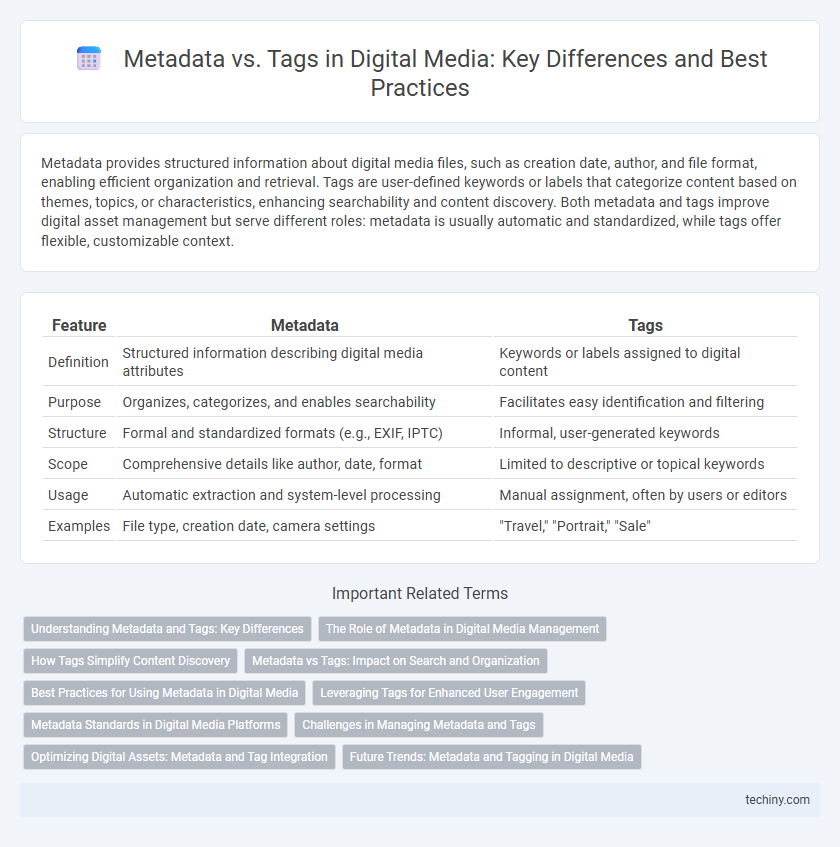Metadata provides structured information about digital media files, such as creation date, author, and file format, enabling efficient organization and retrieval. Tags are user-defined keywords or labels that categorize content based on themes, topics, or characteristics, enhancing searchability and content discovery. Both metadata and tags improve digital asset management but serve different roles: metadata is usually automatic and standardized, while tags offer flexible, customizable context.
Table of Comparison
| Feature | Metadata | Tags |
|---|---|---|
| Definition | Structured information describing digital media attributes | Keywords or labels assigned to digital content |
| Purpose | Organizes, categorizes, and enables searchability | Facilitates easy identification and filtering |
| Structure | Formal and standardized formats (e.g., EXIF, IPTC) | Informal, user-generated keywords |
| Scope | Comprehensive details like author, date, format | Limited to descriptive or topical keywords |
| Usage | Automatic extraction and system-level processing | Manual assignment, often by users or editors |
| Examples | File type, creation date, camera settings | "Travel," "Portrait," "Sale" |
Understanding Metadata and Tags: Key Differences
Metadata provides structured, comprehensive information about digital media files, such as creation date, file size, author, and technical specifications, enabling efficient organization and retrieval. Tags are user-generated keywords or labels that describe the content or context of media, facilitating quick searching and categorization but lacking standardized format. Understanding the distinction between metadata's formal attributes and tags' flexible, descriptive nature is crucial for effective digital asset management.
The Role of Metadata in Digital Media Management
Metadata plays a crucial role in digital media management by providing detailed information about media files, facilitating efficient organization, search, and retrieval. Unlike tags, which are often simple keywords added for categorization, metadata encompasses a wide range of structured data such as creation date, file format, author, and usage rights, enhancing content discoverability and compliance. Effective metadata management supports automated workflows, improves content accessibility, and enables advanced analytics in digital asset management systems.
How Tags Simplify Content Discovery
Tags enhance content discovery by providing specific, user-friendly keywords that describe the content's theme, making it easier for users to find relevant digital media quickly. Unlike metadata, which is often technical and embedded within files, tags are openly displayed and can be customized by users to reflect current trends and preferences. This flexibility accelerates search accuracy and improves the overall user experience on digital platforms.
Metadata vs Tags: Impact on Search and Organization
Metadata provides structured, detailed information about digital media files, enhancing search precision and enabling advanced organization through attributes like date, author, and file type. Tags offer flexible, user-generated labels that improve content discoverability by allowing multiple, customizable descriptors, facilitating quick retrieval across diverse platforms. Combining well-defined metadata with relevant tags optimizes digital asset management and significantly improves search accuracy and content organization.
Best Practices for Using Metadata in Digital Media
Effective use of metadata in digital media enhances content discoverability, organization, and management across platforms by providing detailed, standardized information such as creator, date, format, and rights. Best practices include maintaining consistent metadata schemas, embedding metadata directly within media files, and regularly updating metadata to reflect changes or additions. Leveraging controlled vocabularies and automated tagging tools can improve accuracy while ensuring compliance with industry standards like Dublin Core or IPTC.
Leveraging Tags for Enhanced User Engagement
Tags play a crucial role in enhancing user engagement by organizing digital media content into easily discoverable categories, facilitating more accurate content recommendations and personalized experiences. Unlike metadata, which provides structured technical and descriptive information, tags are user-generated keywords that capture the context and themes of media, enabling dynamic content filtering and improved searchability. Leveraging tags effectively increases content visibility, drives interaction, and fosters community participation within digital media platforms.
Metadata Standards in Digital Media Platforms
Metadata standards in digital media platforms ensure consistent description, organization, and retrieval of media assets across diverse systems. Common standards like Dublin Core, IPTC, and XMP provide structured frameworks for embedding essential metadata such as creator, date, format, and copyright information. Implementing these standards enhances interoperability, searchability, and rights management within digital asset management and content distribution networks.
Challenges in Managing Metadata and Tags
Managing metadata and tags in digital media presents challenges such as inconsistent application, leading to difficulties in content retrieval and organization. Metadata schemas often vary across platforms, causing interoperability issues and duplicative efforts in tagging. Ensuring accuracy and standardization requires continuous oversight and advanced tools to automate and validate metadata and tag assignments.
Optimizing Digital Assets: Metadata and Tag Integration
Metadata provides structured information such as file type, creation date, and author, which enhances digital asset management systems' searchability and organization. Tags offer flexible, user-generated keywords that improve content discoverability and context relevance in digital media platforms. Integrating metadata with tags optimizes digital assets by combining precise technical details with dynamic categorization for efficient retrieval and enhanced user experience.
Future Trends: Metadata and Tagging in Digital Media
Future trends in digital media emphasize the integration of AI-driven metadata and advanced tagging systems to enhance content discoverability and personalization. Semantic metadata will enable more precise content classification, improving search accuracy and user engagement across platforms. Automated tagging using machine learning will streamline content management workflows, making metadata more dynamic and context-aware.
Metadata vs Tags Infographic

 techiny.com
techiny.com